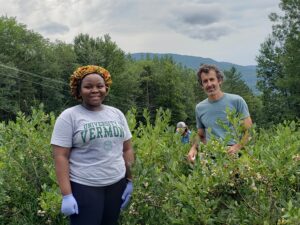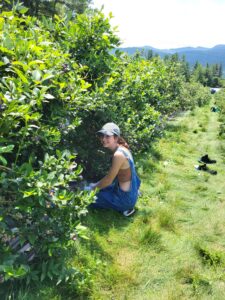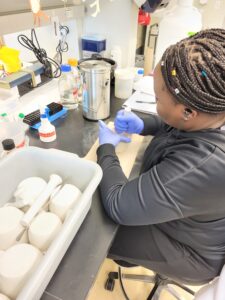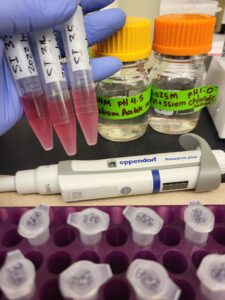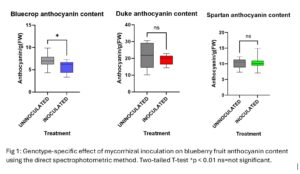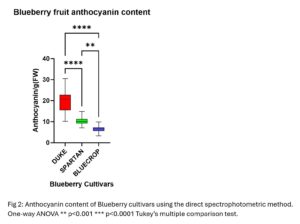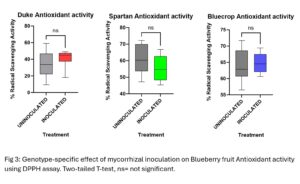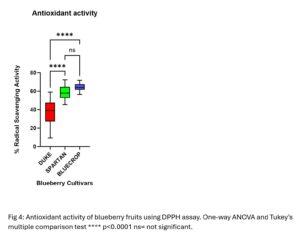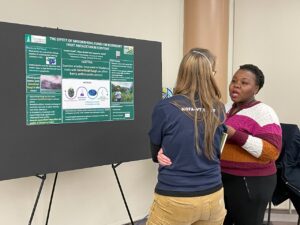Progress report for GNE22-295
Project Information
Inoculation with mycorrhizal fungi is known to promote plant growth. Studies have demonstrated this benefit using arbuscular mycorrhizae but the effect of Ericoid Mycorrhizal Fungi (EMF), which forms beneficial associations with blueberry roots is poorly understood. Blueberries are classified as "superfoods" because they contain antioxidants such as anthocyanins which help the immune system to fight disease. To address consumer interests in superfoods, decrease phosphate run-offs and reduce fertilizer inputs; farmers have turned to sustainable practices such as inoculation with commercial EMF but lack information on whether inoculation will influence the healthful attributes of blueberry fruits. The objective of this project is to determine the anthocyanin content and antioxidant activity of blueberry fruits in EMF-inoculated and uninoculated plants and identify gene expression patterns altered in response to EMF inoculation. I hypothesize that the anthocyanin content and antioxidant activity of blueberry fruits will differ, and this difference may be further understood by changes in gene expression. Using biochemical analysis and RNA sequencing data, my results will provide an insight into the role of EMF on fruit quality and give farmers adequate facts to make informed decisions about the short- and long-term effects of inoculation. The results of the project will be presented at meetings with the Vermont vegetable and berry growers association, American Society of Plant Biologists, NOFA-VT and the academic community.
The goal of this research is to examine whether inoculation of blueberry roots with beneficial fungi can affect berry anthocyanin content that promotes good health and makes it a superfood. This information will be useful for farmers to make informed decisions about sustainable practices that influence fruit quality and improve plant growth. Using laboratory experiments, the proposed research will address two objectives:
Objective 1: Determine the anthocyanin content and antioxidant activity in blueberry fruits from both EMF-inoculated and uninoculated plants. This will enable me to examine whether there is an impact of EMF inoculation on fruit quality.
Objective 2: Identify gene expression patterns in blueberry fruits from inoculated and uninoculated plants. I will conduct RNA sequencing experiment on blueberry fruits obtained from inoculated and uninoculated plants. This will enable me to identify what genetic factors are driving the phenotypic changes we may observe.
The purpose of this project is to evaluate the effect of mycorrhizal fungi inoculation on fruit anthocyanin content and gene expression in Northern Highbush Blueberry (Vaccinium corymbosum var. bluecrop). The goal is to see whether inoculation of blueberry roots with beneficial fungi can influence berry anthocyanin content that promotes good health and makes it a superfood.
Inoculation with mycorrhizal fungi can increase growth of highbush blueberry plants in northeastern U.S. (Yang et al., 2002). Beneficial microbial inoculants such as Arbuscular Mycorrhizal Fungi (AMF) can also improve plant defense (Maffei et al, 2014), enhance soil carbon sequestration (Wu et al, 2014), and benefit plant nutrition status by increasing nutrient uptake (Zhu et al, 2016). The use of mycorrhizal fungi inoculation is gaining increased attention by the sustainable agriculture movement because it promotes the use of natural resources without degrading the environment (Rashid et al, 2019). Benefits of inoculation with AMF have been seen in several crops such as citrus (Abobatta, 2019), tomato (Hart et al, 2015) and strawberry (Cecatto et al, 2016, Lingua et al, 2013, Cordeiro et al, 2019), but little is known about the effect of ericoid mycorrhizal fungi (EMF), which forms a mutual association with ericaceous plants such as blueberries, on fruit quality.
Over the years, people have become increasingly aware of their health and the need to invest in foods that promotes wellbeing. This awareness has given rise to lifestyle changes as people turn to food with high nutritional value to improve the quality of life (Proestos, 2018). Blueberries are one of the healthiest and most nutritious dietary sources, due primarily to its high antioxidant activity (Nicoletti et al, 2015), and are recommended as a “superfood” to help strengthen the immune system (Wolfe, 2009). To address the changing consumption pattern and consumer interests, farmers are tasked with the responsibility of growing these superfoods to have better quality. They adopt sustainable practices such as inoculating with beneficial mycorrhizal fungi to reduce fertilizer inputs and decrease phosphate run-offs; this requires the purchase of commercial mycorrhizal fungi which manufacturers claim promotes plant growth but attributes of its effect on berry fruit quality is poorly understood.
Although an increase in blueberry mass by EMF is observed on a genotype-specific basis (Brody et al, 2019), the major concern of the farmer should be the commercial value and economic returns. How can farmers tell whether inoculation influences fruit anthocyanin content and fruit quality? Does the type of inoculum affect the quality of berries produced? This is a knowledge gap which my project aims to address and provide information that can help farmers make informed decisions about the effects of inoculation and its contribution to environmental and economic sustainability.
Research
Sampling design: The experimental plants are Northern Highbush Blueberry plants located at the Waterman Orchards in Johnson, VT. These plants were inoculated with mycorrhizal fungi about 12 years ago. The initial design was to have samples from Bluecrop cultivars, but I expanded the sampling design to include the cultivars Duke and Spartan whose floral traits were shown to be influenced by ericoid mycorrhizal inoculation. Bluecrop cultivar is the most widely planted in Vermont and provides fruits all summer and in early fall. Duke cultivar is known to be cold hardy and can produce berries well into late fall while Spartan fruits are from June to August and can withstand cold winter. Random sampling was done in one row per cultivar per treatment (inoculated vs uninoculated). The 3 cultivars chosen for sampling were all grown within the same block with each pair of rows (inoculated and uninoculated) 3 meters apart. The rationale is to maintain as similar an environment as possible so that the inoculation treatment is the main difference.
Sample collection: I have completed the sample collections for the first and second year. I collected 24 berries sampled from 4 branches per plant. Mature and immature berries were harvested separately from each plant. Anthocyanins are the major flavonoids in berries and the choice of immature and mature fruits is because accumulation of anthocyanins begins at the onset of ripening. I randomly sampled 10 plants per treatment for each of the 3 cultivars, so a total of 60 plants were sampled. Spartan cultivar was at the end of harvest when I sampled in the first year so total mature berry number was low and very few plants had immature berries. The sampled fruits were placed in labelled Ziploc bags, frozen with liquid nitrogen, and stored at -800C. For the first year of sample collection, I was assisted by Tom Michaels (a UVM student who has since graduated). For the second-year sample collection, I was assisted by Mia Randolph, a Plant Biology major at UVM.
Sandra Nnadi with Ben Waterman at the Waterman Orchards, Johnson VT
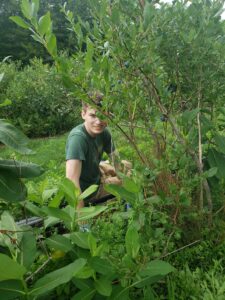
Mia Randolph at the Waterman Orchards, Johnson VT in 2023.
Objective 1: Determine the anthocyanin content and antioxidant activity in blueberry fruits.
To test objective 1, I will use two different approaches. The first will directly measure berry anthocyanin content. The second will measure the antioxidant activity present in the berries. I am currently optimizing the anthocyanin and antioxidant assays that will be applied on the samples.
Experiment 1.1 Determine blueberry anthocyanin content.
I successfully optimized the anthocyanin assay and extracted anthocyanin from the blueberry samples harvested in the first year. To prepare the samples for Anthocyanin extraction, I measured frozen berries (3 fruits per sample) and ground them into powder with liquid nitrogen in a ceramic mortar and pestle. I stored the ground tissue in a 50ml falcon tube at 80oC. To extract Anthocyanin from the blueberry samples, I measured ground tissue and added 2 µl of extraction buffer (1% HCL in Methanol) per mg tissue to each sample, homogenized the samples using a vortex mixer and centrifuged at high speed for 5 mins. I transferred the supernatant into a new 15ml falcon tube and repeated the process until the pellet turned white. To determine the Anthocyanin content, I used a UV spectrophotometer to measure the absorbance (at 530 nm and 657 nm) of the sample extracts.
I also validated the results obtained with the pH differential method. For this method, I prepared two buffers, pH 1.0 Potassium chloride and pH 4.5 Sodium acetate. I used two sets (A & B) of each sample extract and added each buffer to the samples set A and B respectively. I measured absorbance at 530nm and 700nm.
Experiment 1.2: Measure berry Antioxidant activity (DPPH Assay)
DPPH (2,2-diphenyl-1-picrylhydrazyl) is a violet-colored (free radical) reagent when dissolved in Methanol. The presence of an antioxidant molecule reduces the DPPH free radical to give a pale-colored solution. The absorbance of the solution is measured (517nm) with a spectrophotometer and the value obtained is used to calculate the amount of antioxidant activity of the sample extracts.
I optimized the DPPH assay protocol to determine the antioxidant activity of the blueberry sample extracts. I prepared 0.1mM DPPH solution in 100ml of Methanol. I added 1ml of 0.1mM DPPH solution to 1ml of sample extract, mixed it thoroughly and kept in the dark for 30mins. Using a UV Spectrophotometer, I measured absorbance at 517nm. DPPH solution without sample added was used as the control while 1% HCL in Methanol was used as the blank.
Objective 2: Identify gene expression patterns in blueberry fruits from inoculated and non-inoculated plants. I will conduct RNA sequencing experiment on blueberry fruits obtained from inoculated and uninoculated plants. I will also conduct bioinformatics analysis on the sequencing results to identify gene expression patterns. Currently, the RNA sequencing experiment is in progress.
Sandra Nnadi in the laboratory grinding blueberry fruits with liquid nitrogen in a ceramic mortar and pestle.
Sample extracts obtained after Anthocyanin Extraction.
Anthocyanins are very important to the antioxidant capacity of blueberry fruits. Mycorrhizal symbiosis is known to improve plant biomass in general and can influence blueberry floral traits in a genotype-specific way. I asked whether there is an effect of mycorrhizal fungi inoculation on blueberry anthocyanin content. I used two different methods to examine the anthocyanin content of inoculated and uninoculated blueberry fruits of three blueberry cultivars, Duke, Spartan and Bluecrop. I found that there was no significant difference in anthocyanin content between inoculated and uninoculated blueberry samples combined. I found that there was a genotype-specific effect of mycorrhizal inoculation on anthocyanin content of the different blueberry cultivars that were grown on the same field. In the Bluecrop cultivar, there was a significant decrease in anthocyanin content of inoculated samples compared to uninoculated samples. A similar trend of decrease in anthocyanin content of inoculated samples was observed in Duke and Spartan but it was not significant (Fig 1).
I also found that at the cultivar level, there was a significant difference in anthocyanin content. Overall, Duke had significantly higher anthocyanin content than Spartan and Bluecrop (Fig 2). Duke had the lowest average berry mass out of the 3 cultivars, while Spartan had the highest average berry mass (Table 1).
For the Antioxidant activity, I found no significant effect of mycorrhizal inoculation on the antioxidant activity of the blueberry samples combined. Also, there was no significant genotype-specific effect of mycorrhizal inoculation (Fig 3). At the cultivar level, Bluecrop and Spartan had a significant increase in antioxidant activity compared to Duke which significantly decreased in antioxidant activity (Fig 4).
Table 1: Average weight of blueberry fruits prepared for Anthocyanin extraction and Antioxidant activity. N=3 per sample.
|
Treatment/cultivar |
DUKE |
SPARTAN |
BLUECROP |
|
UNINOCULATED |
6.637g |
8.762g |
7.047g |
|
INOCULATED |
6.753g |
10.652g |
7.83g |
Education & Outreach Activities and Participation Summary
Participation Summary:
It is important for results of funded applied research projects to reach farmers. Effective communication strategies can make reporting more understandable and create more sustainable farming opportunities. One of my goals for this project is to ensure that farmers, scientists, and the academic community is informed about the progress of the project and its outcomes.
I presented a poster describing the ideas and methods for the project at the NOFA-VT winter conference 2023 which was held at UVM on Feb 18th, 2023. The Northeast Organic Farming Association of Vermont conference was an opportunity to meet with organic farmers and community partners who work towards a viable agricultural system. My poster which highlighted my research ideas attracted a lot of participants and fostered good feedback and discussions. I will be presenting the results from the analysis of the first-year samples at the NOFA-VT winter conference on February 17th, 2024.
Sandra Nnadi presenting a scientific poster to a participant at the NOFA-VT winter conference in February 2023 at the University of Vermont.
Poster highlighting research ideas presented at the NOFA-VT winter conference in February 2023.
